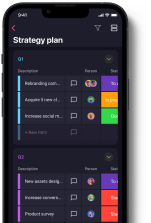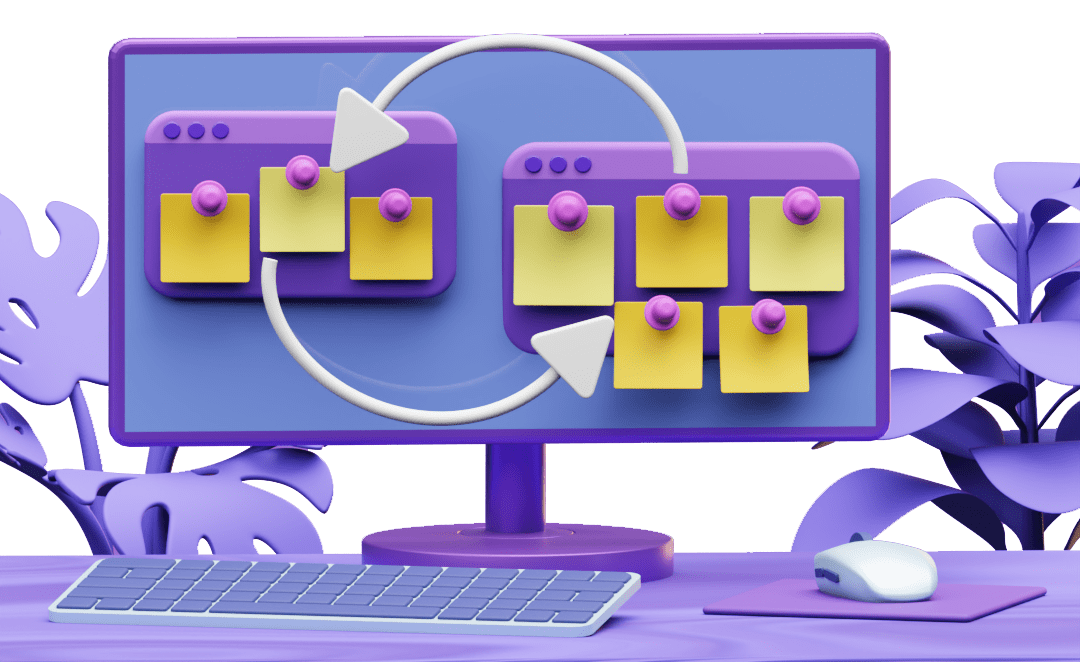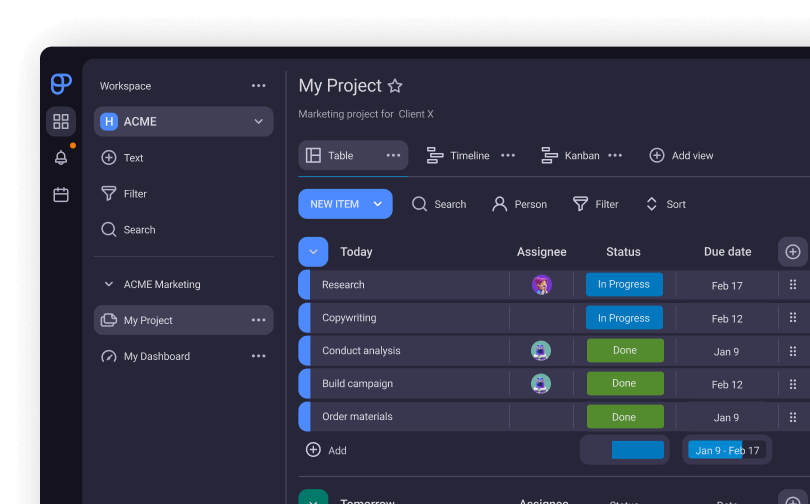Project Manager Roles and Responsibilities: Everything You Need to Know
Project management has been around since the dawn of civilization. And yet, to most people, the role of project management — and by extension, project managers — is not always clear.
There are many reasons for this — from requirements and specifics varying across different industries to vague job descriptions. As such, it can be difficult to visualize exactly what goes under the role of a project manager.
In this article, we’ll explain the role in greater detail, taking a closer look at the key responsibilities and duties that every project manager has. We’ll even offer some pointers on how to start a career in project management.

Table of Contents
Who are project managers?
The 7th edition of the Guide to the Project Management Body of Knowledge (PMBOK) defines a project manager as follows:
“Project manager. The person assigned by the performing organization to lead the project team that is responsible for achieving the project objectives. Project managers perform a variety of functions, such as facilitating the project team work to achieve the outcomes and managing the processes to deliver intended outcomes.”
That said, project managers are highly organized and goal-oriented people who:
- Lead projects in ways that align with the business goals and strategies of their organization (or their client), and
- Try to deliver on set promises within an agreed budget, before the project deadline.
For a simple analogy, it’s best to imagine a project manager as a ship captain whose job it is to ensure the vessel arrives at its destination.
This means not only setting the course but also adjusting the route during the journey to avoid whatever problems might arise.
On top of that, it also involves overseeing operations on the ship itself to ensure everyone is doing their job and everything is functioning properly.
💡 Plaky Pro Tip
Thrive as a project manager by learning how to start a project in just a few easy steps. Find out more below:
Project manager vs product manager
The roles of project manager and product manager often get confused due to the similar titles and overlapping skill sets. However, it’s important to make a distinction between the two.
So, what’s the difference between a project manager and a product manager?
A product manager’s responsibility is to:
- Decide which product is worth pursuing,
- Understand the product,
- Gather requirements,
- Define its main features, and
- Prioritize the work needed to complete the product.
A project manager’s responsibility is to:
- Organize the work that will need to be done to create that product, and
- Make sure it gets delivered on time, within budget, and within scope.
In other words, a product manager creates a vision for the product. A project manager helps bring that vision to life.
Due to a lack of skilled professionals, these 2 roles may sometimes be performed by the same person. But, ideally, a project should have both a project manager and a product manager on board.
💡 Plaky Pro Tip
The role of a project manager often gets confused with other similar roles. Check out how it differs from the role of product owner:
What is a project in project management?
To better understand the roles and responsibilities of project managers, it’s best we also explain what a project is.
According to the project definition from the Association for Project Management (APM), a project is “a unique, transient endeavor undertaken to achieve planned objectives, which could be defined in terms of outputs, outcomes or benefits.”
Furthermore, the 7th edition of PMBOK offers a similar definition of a project as “a temporary endeavor undertaken to create a unique product, service, or result.”
A normal project life cycle usually consists of the following five project phases:
- Initiation — establishing the need for a project, establishing the project’s objectives, and getting kickoff approval from key stakeholders,
- Planning — creating a detailed guide for execution that includes the project scope, constraints, work breakdown structure (WBS), schedule, and risk analysis,
- Execution — creating deliverables,
- Monitoring and controlling — tracking the project’s progress, keeping an eye out for signs of scope creep, and course-correcting when necessary, and
- Closing — getting final approvals from key stakeholders, reviewing the project, and archiving it for future reference.
💡 Plaky Pro Tip
If you’re curious about learning more about these 5 processes, check out our comprehensive guide through a project’s typical lifecycle.
What are the roles and responsibilities of a project manager?
While “project manager” is a role in itself, it is a multifaceted position that usually requires one individual to wear many hats, depending on the exact requirements of their position in the company.
In essence, a project manager must be versatile and possess the following skills:
- Organization — managing time, workload, and resources effectively,
- Communication — maintaining open and efficient communication with team members, stakeholders, clients, and upper management,
- Leadership — ensuring good morale and cohesion in the project team, and
- Adaptability — adapting to changing situations and requirements.
That said, here are the key responsibilities a project manager will have over the course of a project:
- Define scope,
- Plan and organize tasks,
- Manage resources,
- Create, organize, and motivate teams,
- Assess and manage risks,
- Manage changes,
- Negotiate with contractors and suppliers,
- Communicate with stakeholders,
- Document progress,
- Collect signatures, and
- Help improve employee engagement.
Let’s see what each of these responsibilities entails in more detail.
Responsibility #1: Define scope
One of the first things a project manager needs to do after a project is approved is define the project scope.
The scope is the direct result of the project manager’s understanding of the project, as well as a detailed layout for all the work that needs to be done in the future.
This makes defining scope a vital step in project planning. If done incorrectly, it can doom a project to failure from the very beginning. To avoid this, it’s important to prepare a detailed scope statement and get it approved by all key stakeholders.
When creating a project scope, the key points a project manager needs to cover are:
- Defining concrete goals the project aims to achieve,
- Outlining the resources required to carry out the project, and
- Monitoring and adapting the scope as the project progresses.
💡 Plaky Pro Tip
For a more in-depth look at the project scope and a detailed guide on how to create one, take a look at the following article:
Responsibility #2: Plan and organize tasks
Although it sounds like a one-time commitment, planning and organizing tasks is something that has to be done continuously, throughout the entire project.
It includes processes such as:
- Creating a project plan,
- Creating a project management plan,
- Creating a scope management plan,
- Creating a risk management plan,
- Creating a work breakdown structure (WBS),
- Creating a project roadmap,
- Scheduling,
- Planning report meetings, and more.
Planning allows project managers to:
- Form a clear idea of what needs to be done,
- How it needs to be done,
- By whom it needs to be done,
- When it needs to be done, and
- Within what project constraints it needs to be done.
Planning also serves to create clear guidelines for how risk, scope, change, budget, and schedules will be handled from start to finish.
Moreover, it involves allocating and prioritizing tasks, forming teams, and establishing a hierarchy so that everyone has a clear understanding of whom they should be reporting to or asking for help at any given time.
💡 Plaky Pro Tip
The planning stage may vary significantly based on what approach or methodology is best suited for the project at hand. To learn more about the project management methodologies that are commonly used today, take a look at this article:
Responsibility #3: Manage resources
Project resources refer to all the resources required to successfully complete a project or task, including:
- People,
- Time,
- Money, and
- Tools.
Seeing as project resources are often limited by the scope, the ability to effectively distribute and manage them is critical.
Here, a project manager needs to ensure that:
- The project teams are adequately staffed,
- Each team and team member has a manageable workload,
- Deadlines are realistic and achievable,
- The team has the necessary resources to complete their tasks,
- Everyone has the tools they need,
- The budget is managed efficiently,
- All resources are reorganized and adapted to changing situations, and more.
💡 Plaky Pro Tip
Time management isn’t about determining the exact amount of time a task might take. Instead, it’s important to account for delays and leave “wiggle room” for the team, which is where float comes in. To learn more about float, take a look at this article:
Responsibility #4: Create, organize, and motivate teams
A project manager is more than just someone managing workflows, distributing tasks, rotating resources, and sorting documentation. They are also in charge of people involved in the project, and so they must fill leadership roles.
With larger projects, a project manager will organize several teams, whereas in smaller ones, they usually fill the role of team lead as well.
Either way, the project manager must take steps to ensure that each team is:
- Comprised of compatible people, and
- Staffed sufficiently to meet their objectives.
Furthermore, it’s up to the project manager to foster an atmosphere of trust and keep the team motivated — meaning they must also possess the soft skills necessary to excel in a leadership role, such as communication and teamwork.
💡 Plaky Pro Tip
Since a good manager needs to master a blend of both hard and soft skills to properly manage a project, you may want to learn more about what these skills are:
Responsibility #5: Assess and manage risks
Risk assessment and management is — once again — a process, rather than a step in project management.
It’s done regularly throughout the project to identify potential threats to its development and to either eliminate or contain them. Problems such as software bugs, supplier issues, equipment malfunction, and other complications can all arise at any moment, so it’s vital to be prepared.
“Preparation” in this context can vary based on the approach the project manager is taking.
For example, the Waterfall methodology involves extensive planning for any number of situations. Meanwhile, with the Agile approach, it means ensuring the team has the flexibility to adapt to unforeseen changes.
Either way, periodic risk assessments allow project managers to anticipate potential risks before they happen and take steps to prevent them ahead of time — thus reducing the possibility of scope creep, budget creep, or some of the tasks losing focus and getting sidetracked.
💡 Plaky Pro Tip
For a more in-depth look at risk in project management and how to manage it, take a look at the following articles:
Responsibility #6: Manage changes
Changes are an inevitable part of any project. But, just because they’re unavoidable doesn’t mean they cannot be properly managed.
To avoid alterations wreaking havoc on your schedules, it’s important to constantly monitor the plan and establish a change control procedure. The goal of this procedure is to:
- Discourage people from suggesting unnecessary changes,
- Make sure only the necessary changes are approved, and
- Avoid scope creep.
The change control procedure will often include a filled-out change request form. This is where the person suggesting changes is meant to justify the reasons for the change and explain the impact it will have on the project as a whole.
The form is then:
- Reviewed,
- Discussed with relevant stakeholders, and
- Either accepted or rejected.
Managing changes based on the pre-established change control plan is a process that should be continuously performed throughout the project.
We have reached out to Zoran Vizmeg, Project Manager at CAKE.com, for his input on the subject.

“During project execution, plans can have minor flaws. Those flaws must be detected and solved. Imagine that you have massive machinery with lots of different types and sizes of gears. As PMs, we must arrange those gears into perfect working order, listen to them, and lube if they squeak somewhere until we perfect that mechanism.”
Responsibility #7: Negotiate with contractors and suppliers
Many think that the job of project managers comes down to being neck-deep in paperwork, and to some extent, that’s true — but a lot of it has to do with people as well.
Negotiating contracts and rates is one of the crucial responsibilities a project manager has, and it directly correlates with managing project resources.
To be good at negotiating, a project manager must:
- Be good at handling people,
- Have excellent communication skills, and
- Always keep in mind that negotiation is not a competition.
In other words, the goal is not to out-negotiate the other person but to reach a mutually beneficial deal.
If a project manager is capable of securing a good deal with a reliable contractor and/or supplier, it can have wide-reaching benefits throughout the rest of the project.
Responsibility #8: Communicate with project stakeholders
A major responsibility project managers have is to maintain constant communication with all key stakeholders for the duration of the project.
The point of this communication is to:
- Keep the stakeholders informed about the project’s progress,
- Gain feedback and approval regarding changes or finished deliverables, and
- Avoid major changes near the end of the project.
In theory, this sounds entirely logical, straightforward, and easy to do. In practice, however, the situation is usually different.
A common occurrence in project management are stakeholders who:
- Think they know what they want,
- Think they communicated what they wanted clearly in the first meeting, and
- Think that their remaining involvement in the project consists of waiting for the final product to be delivered to them.
In cases like these, project managers must be bold, assertive, and insistent. This often includes persistently “chasing” stakeholders to get the required feedback and approval as the project progresses.
Failing to do this can often lead to subpar results — the client might not get what they imagined, as neither side pushed hard enough to establish expectations and clear up any potential misunderstandings. The ultimate responsibility, however, falls on the project manager.
Responsibility #9: Document progress
It’s not uncommon to see project managers unhappy about having to waste time on mountains of paperwork.
In fact, a project management survey from RGPM asked their respondents about the one thing they would like to take off their to-do list, and “writing stupid reports that nobody reads” was one of the answers, word-for-word.
However, though it may appear like nothing but a waste of time at face value, documenting all changes, approvals, and progress is an important part of a project manager’s job.
Some of the most important documents project managers need to write are:
- Business case,
- Project charter,
- Work breakdown structure (WBS),
- Scope statement,
- Scope management plan,
- Status reports, etc.
Even if most of them end up filed away and forgotten, each of these documents has a specific purpose. It’s always better to have them than not have them in case of emergencies or potential legal issues.
Detailed documentation, when properly reviewed and archived, can also serve as a point of reference for similar projects in the future and help prevent the issues that plagued past projects.
Responsibility #10: Collect signatures
If you think you’re finished with a proposal, scope statement, an important deliverable, or even the entire project, and you don’t have all the signatures to prove it — it’s time to pay another visit to the stakeholders.
A signature at the bottom of any project management document is the sign that the document has been reviewed and approved. It serves as a formal affirmation that both you and the client agree that the work that was agreed upon is finished and that everyone is satisfied with the results.
Official sign-off can prevent a number of issues, from simple miscommunication to stakeholders deliberately abusing their position. That said, it can even serve as evidence in case of a legal dispute.
Responsibility #11: Help improve employee engagement
Nowadays, most businesses recognize the importance of employee engagement in an organization. And given that the latest data on employee engagement from Gallup shows that almost 60% of employees are quiet quitting, it’s no wonder companies are striving to improve on this front.
In addition to the longer-reaching effect on companies as a whole, low engagement can be especially detrimental for individual projects for a number of reasons:
- Disengaged employees are more likely to make mistakes,
- Subpar work requires more resources for corrections,
- Team members can be demoralized due to their colleagues leaving,
- Organizational issues can arise due to important positions being left vacant, and more.
As we’ve already established, a project manager will inevitably lead one or multiple teams and is thus also often involved in the company’s employee engagement strategy.
Some of the ways a project manager can help improve engagement are:
- Ensure every team member feels acknowledged in their role,
- Offer employees flexibility and autonomy in how they approach their tasks,
- Create incentives to promote productivity and accountability,
- Prevent overtime or undue stress,
- Regularly collect feedback,
- Participate in planning team-building exercises,
- Participate in planning professional development activities and workshops.
Of course, the exact level and nature of a project manager’s engagement will depend on a number of factors — from the size of the project team to the specifics of the company’s employee engagement strategy.
💡 Plaky Pro Tip
Employee engagement is closely tied to employee experience (EX), and the 2 terms are also sometimes conflated. To learn more about employee experience, take a look at this article:
What do project managers do in different industries?
Regardless of the industry, project managers are leaders and coordinators whose main responsibility is to keep the project from going off the rails and help it reach its final goal.
However, there are differences from industry to industry. This is exactly what we’ll be discussing next by taking a look at a few examples of what project managers do in different industries — namely:
- Information technologies,
- Human resources, and
- Construction.
IT project manager responsibilities
When talking about IT, people usually think of software development. However, IT project management can also include managing IT processes and software used within an organization.
Much like any other project manager, a PM in the software industry is required to:
- Map out the project,
- Allocate tasks and resources,
- Schedule tasks,
- Organize workflow,
- Communicate with stakeholders, and more.
However, due to the nature of software development, there are lots of moving parts and task dependencies, which means managers must also be quick-thinking and adaptable.
This is precisely why the IT industry favors an Agile approach to project management, which prioritizes flexibility over complex planning. This allows teams to deliver a functional project faster and resolve issues as they arise.
Furthermore, the IT industry itself is changing rapidly. So, an IT project manager must be adaptable and open to learning over the course of their career in order to stay ahead of the latest innovations and changing trends.
💡 Plaky Pro Tip
Interested in learning more about software development or looking for better tools for the job? Here are a few articles you may find interesting:
Construction project manager responsibilities
In contrast to IT, construction is an industry that lends itself much better to traditional project management approaches.
For the most part, a project manager in construction has most of the same responsibilities as any other. However, due to the nature of construction projects, the priorities are a bit different, as the focus is placed on:
- Time management,
- Resource and equipment management, and
- Workplace safety.
First and foremost, time management is crucial in construction projects, as they usually involve lots of manpower, raw materials, and expensive equipment. As such, any delays can lead to significant losses for the stakeholders and the company, and the project manager should always develop a meticulous construction schedule.
Managing equipment is another important element in construction project management. Namely, construction relies on lots of vehicles and machines that are very energy-intensive and require careful operation and maintenance.
Finally, there’s also the matter of safety. Construction is one of the most dangerous professions — according to data on workplace injuries from the US Bureau of Labor Statistics, 35% of fatalities in construction and extraction industries are caused by falls, slips, and trips.
On top of that, the same statistics show that over 60% of construction workers are exposed to heights and moving mechanical parts, and over 25% are exposed to hazardous substances without adequate protection.
That said, a project manager in construction has to worry about a lot more than cost efficiency and the bottom line, as they are also quite literally responsible for people’s lives and well-being. As such, ensuring compliance with safety regulations is among the most important responsibilities of a project manager in this industry.
💡 Plaky Pro Tip
Looking for an easier way to create a construction schedule? You can take a look at Plaky’s template below:
HR project manager responsibilities
Hiring new employees is often the first thing people think of when they think of HR.
While this is an important part of an HR professional’s job, it’s only a small part of the job description. In most organizations, lead HR specialists function as project managers.
Compared to other industries, HR project management is more people-oriented than product-oriented. Just like with any other project manager, their responsibilities also include planning, scheduling, and executing a string of smaller tasks that eventually get the project done — but most of the time, the end result of a project is intangible.
For example, HR project managers are responsible for:
- Turning business objectives into a series of actionable plans for future projects,
- Facilitating meetings,
- Motivating and coaching team members and other team leaders,
- Writing progress reports,
- Communicating with third parties,
- Implementing communication policies within an organization, and
- Ensuring consistency and fairness regarding recruitment, termination, salary, and benefits, and their strict adherence to the law.
In the end, HR project managers are less project managers who work in HR, and more HR professionals with excellent project management skills.
💡 Plaky Pro Tip
Like any other industry, HR project managers need the best tool for the job. If that’s what you’re looking for, we suggest taking a look at the following article:
What do project managers do in different positions?
Like many other careers, project management positions can vary significantly based on the exact nature of the role and the project manager’s experience.
In this section, we’ll briefly explain what some popular project management titles mean, how they differ, and what level of seniority they’re commonly associated with.
Position #1: Project manager
Standing on its own, the base title of “project manager” is hardly descriptive, and it usually refers to someone in a mid-level position. However, depending on the size and structure of the company, it doesn’t necessarily indicate seniority.
Meanwhile, the titles “junior project manager” and “senior project manager” are also used often and are used specifically to indicate seniority. The former refers to an entry-level position, whereas the latter describes a PM with years of experience.
Generally, seniority in a “standard” project management role usually indicates the PM’s position in a hierarchy within a larger company and doesn’t say much about the specifics of the PM’s responsibilities outside of what was defined by the requirements of their workplace.
Naturally, senior personnel might have more responsibility and could be overseeing and training junior project managers, but again — this depends entirely on the specifics of their workplace.
💡 Plaky Pro Tip
How do you become a great project manager? Learn about the most important qualities you should hone in the post below:
Position #2: Assistant project manager
An assistant project manager, as the title clearly suggests, works closely with a more experienced project manager who is in charge of the project as a whole.
This is a junior position with fluid responsibilities and requirements. The assistant PM will be handling whatever work their superior decides to delegate to them out of the responsibilities we’ve touched upon previously.
Position #3: Project coordinator
Another junior role, a project coordinator is usually tasked with a variety of administrative tasks, such as:
- Monitoring the project budget,
- Monitoring the workload and workflow,
- Keeping track of progress on a daily basis,
- Scheduling meetings and other time-sensitive tasks,
- Taking care of miscellaneous documentation, and
- Reporting to the project manager.
That said, the role of a project coordinator is a supportive one, not too dissimilar from that of an assistant project manager.
However, it’s distinguished by the fact it’s focused specifically on the administrative side of things, whereas an assistant PM’s responsibilities can be more varied.
💡 Plaky Pro Tip
Want to read more about the differences between the roles of project manager and project coordinator? Take a look at the following article:
Position #4: Project scheduler
The role of a project scheduler is quite self-descriptive. It is another junior role, much like that of a project coordinator, although a project scheduler has an even narrower focus — scheduling and time management.
Dedicated project schedulers are important for large organizations and projects with lots of interconnected time-sensitive tasks. They ensure the project is proceeding according to the project timeline and work closely with everyone involved to keep things on track.
Position #5: Project management director
In large companies with many ongoing projects, someone has to manage the managers. This is where the role of the project management director comes in as the highest point in the project management hierarchy.
Put simply, a project management director oversees all project managers and their projects, which is extremely important if the projects are interconnected.
Furthermore, the director is in charge of devising long-term project goals for the company as a whole, and thus also plays an important role in the company’s project management office.
Going by our ship analogy from before, if a project manager is a captain guiding a ship, a project management director is an admiral guiding a fleet.
Position #6: Technical project manager
A technical project manager is, as the name suggests, a project manager with technical expertise. As such, technical project managers usually work in IT and have a degree in technology related to their field of work.
For the most part, a technical PM will still have most of the same responsibilities as any other PM, the main difference being the type of projects they work on.
As you’d expect, a technical project manager is required to lead projects that require advanced technical knowledge and expertise in order to be executed successfully.
What software do project managers use?
In this day and age, it would be counterintuitive to pass up on the benefits that digital project management tools offer.
Project management requires flawless organizational skills, the ability to pivot and re-synchronize tasks throughout the project’s life cycle, and keep track of the team’s progress and schedules along the way.
Thanks to digital, collaborative PM tools, this can be made faster and easier in the blink of an eye.
Here are some tools you might already be familiar with, which are simple to use and can greatly optimize the project management process:
- Google Workspace,
- Clockify,
- Pumble, and
- Plaky.
Let’s take a look at them in a bit more detail.
Tool #1: Google Workspace
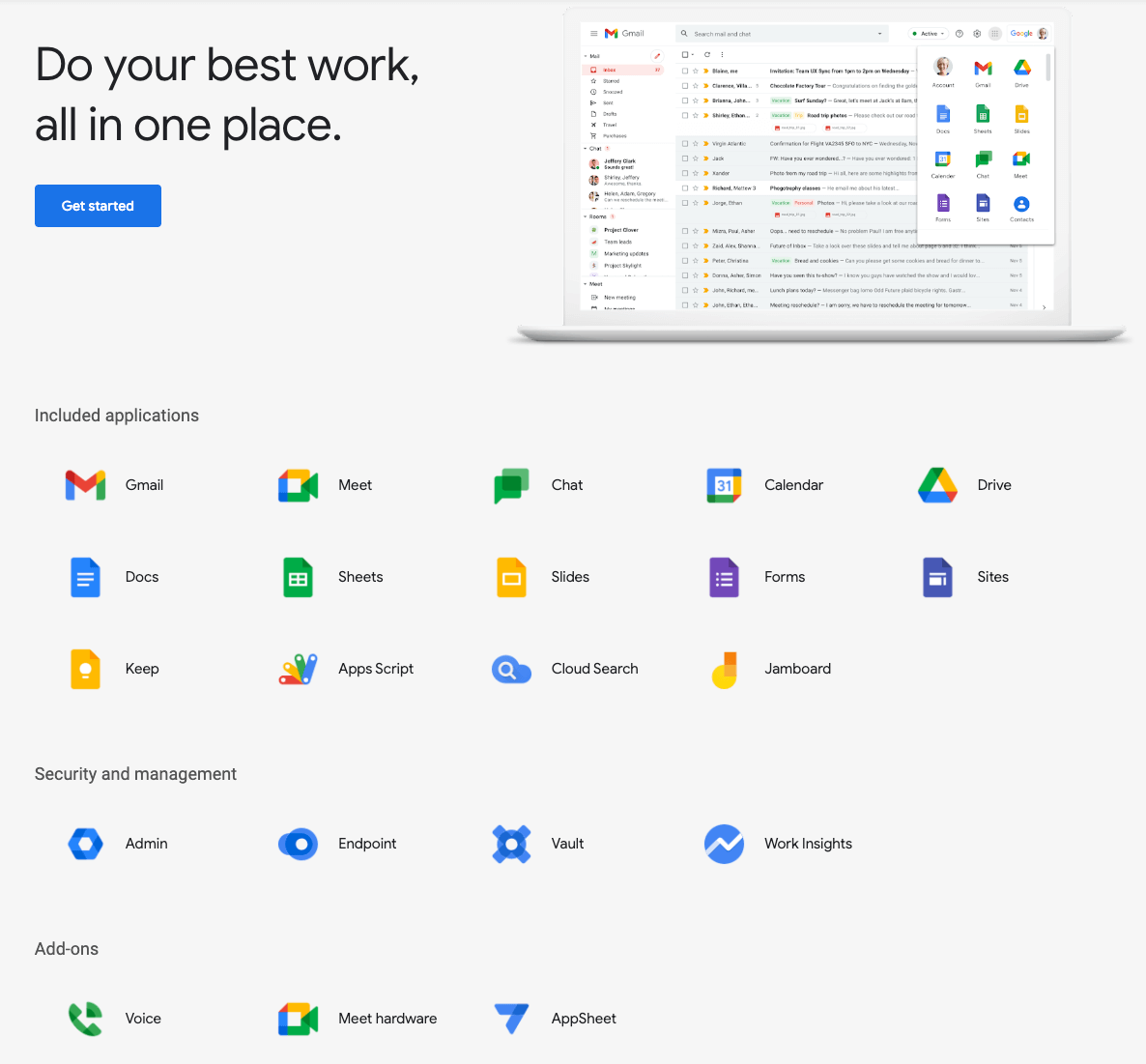
Google Workspace is not technically a tool in itself, but a suite of several powerful cloud-based apps that have become almost ubiquitous in the modern workplace:
- Google Docs — a text editing tool excellent for creating project proposals and reports, as well as seamless collaboration between team members,
- Google Sheets — a spreadsheet app great for planning, scheduling, and creating various charts,
- Google Slides — a presentation app that makes it easy to create rundowns, summaries, and simple reports for either the project team or the stakeholders,
- Google Forms — a survey app especially useful for collecting feedback,
- Google Drive — cloud storage that provides a convenient way to safely store important documents, files, and resources while keeping them readily accessible to all team members,
- Google Calendar — a widely popular app that integrates easily with other scheduling tools and makes it easy to set up meetings, and
- Google Meet — a reliable app for audio and video calls and conferencing.
Overall, Google Workspace apps all provide excellent collaboration tools that work within a highly functional system, complete with integration options for third-party apps. As such, it’s readily apparent why so many project managers make use of them.
Tool #2: Clockify
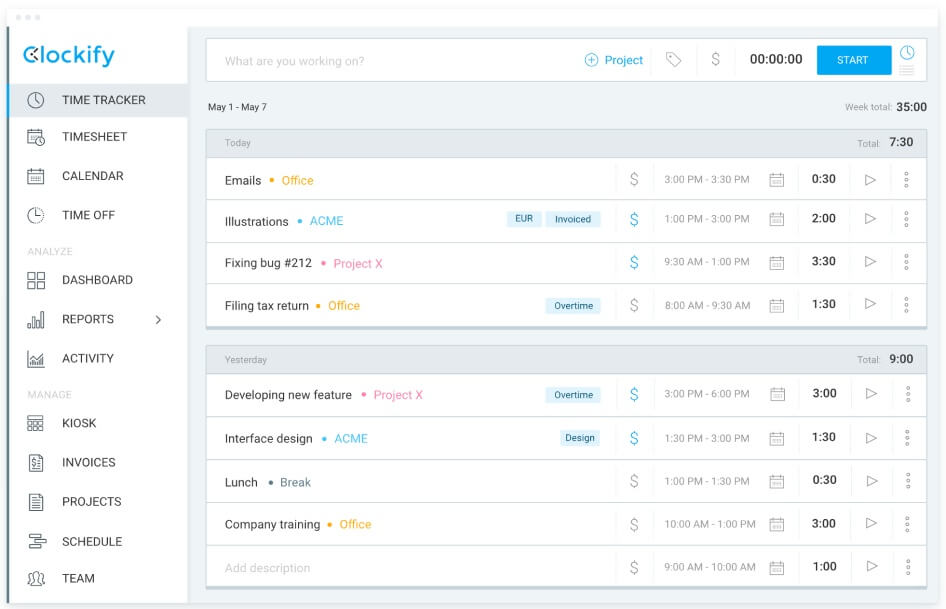
Most projects require meticulous time management, which is where time-tracking apps like Clockify come in.
This app greatly helps with organization, as it comes with:
- An integrated time tracker,
- Calendar,
- Easy-to-review timesheets, and
- A comprehensive dashboard.
Furthermore, the data provided by Clockify can also help project managers track time-based project KPIs, set better deadlines, and assist with workload management.
Tool #3: Pumble
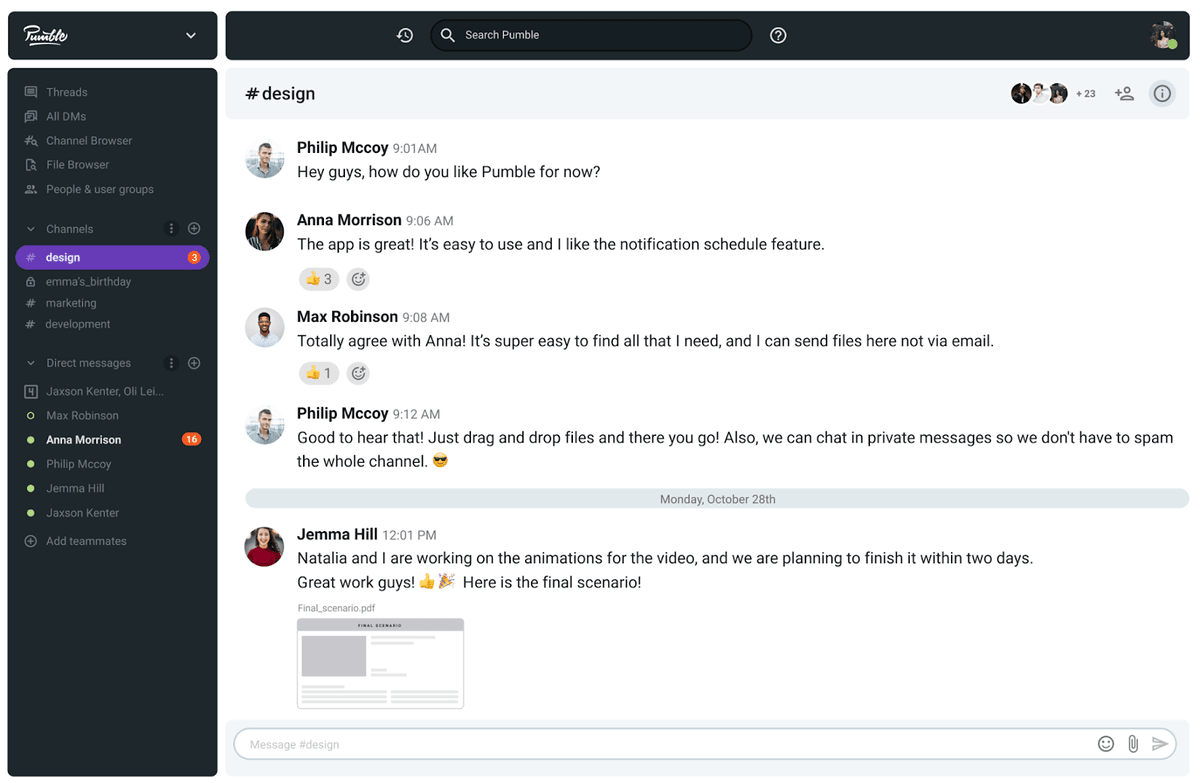
Most project managers will agree that efficient communication is the cornerstone of successful project management. This is precisely why so many project managers today favor specialized communication apps such as Pumble over email.
Pumble allows project managers to:
- Create specific channels and organize them however they wish,
- Communicate directly with team members,
- Set up temporary group chats, and more.
Overall, an app like Pumble saves time and opens up clear and convenient communication channels for everyone in the workspace, all the while keeping the message history saved for easy review.
Tool #4: Plaky
Last but definitely not least, we have Plaky, a project management app that greatly helps with managing both the overall project and the day-to-day tasks.
Its many useful features allow project managers to:
- Create and assign detailed task briefs,
- Track assignees, reviewers, and other relevant personnel,
- Track task progress,
- Choose between different view modes,
- Communicate via comments,
- Share important files,
- Monitor team activity,
- Review past activity and changes,
- Easily identify risks, issues, and bottlenecks, and more.
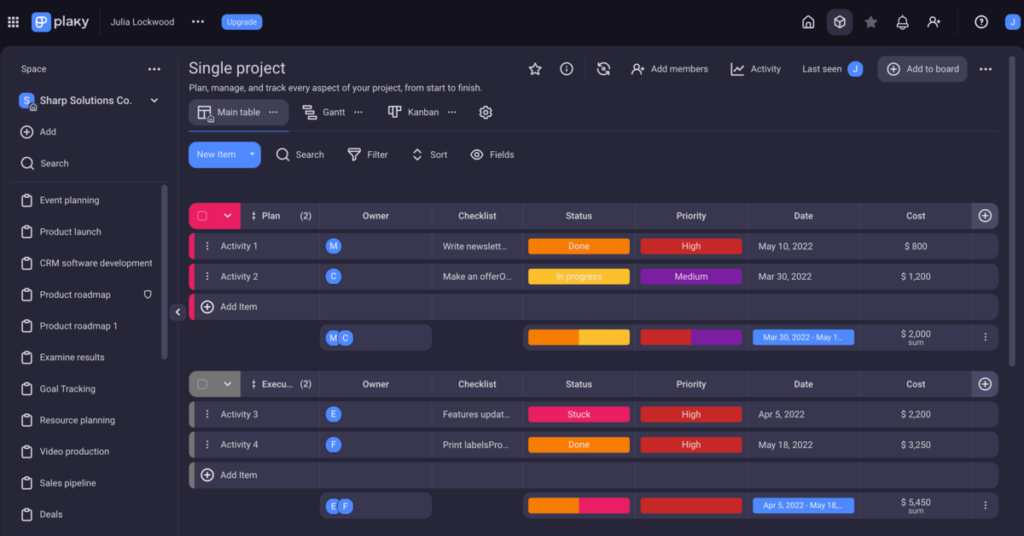
That said, a good project management app allows managers to visualize and organize projects efficiently, all the while keeping all essential information in one place. This greatly increases efficiency and simplifies the technical aspects of the job.
We also asked Zoran Vizmeg about what he finds the most useful about PM software and if he had any preferences, and here’s what he had to say about it:

“You can track tasks and create roadmaps inside a spreadsheet or on a whiteboard, but the main point of project management tools is to help you in that field. These days, there are a lot of project management tools on the market, and whatever you choose, it will certainly help you to some extent. Each tool has pros and cons, and you can go through them and evaluate whatever suits your organization. Jira and ClickUp can certainly help a lot, but Plaky can offer a bit more. It’s easy to use, colorful, has an intuitive interface, and good training resources.”
💡 Plaky Pro Tip
A great source of information on what project managers do comes in the form of project management books. There are quite a lot of them, but we’ve narrowed the list down to the best 20 in this guide:
How to become a project manager
If you’re thinking about becoming a project manager, you’ve picked the right time to do so.
According to PMI’s 2021 Talent Gap Report, the world will need 25 million new project managers by the year 2030. It’s a career with great prospects — as the Financial Times reports, project managers are in short supply, and it’s a “virtually recession-proof” profession.
But, what exactly does it take to become a project manager?
Can anyone do it, or is it reserved for the select few with a project management degree?
These are the questions we’ll cover in the following section.
Who can become a project manager?
As with many other professions, there are universities and colleges around the world that offer degrees in project management. But again, as with many other professions, a degree isn’t always a prerequisite for a successful career.
While not everyone can become a project manager, everyone has a chance to become one with sufficient determination and experience.
Project management experience can be gained through internships and volunteer jobs.
For people without a degree or certification, this is the best way to go about becoming a project manager — internships and career evolution.
On the other hand, those who’ve studied project management and have earned appropriate certifications can hope to land a role as a junior project manager.
Project management certifications
Acquiring a project management certification is not necessary — but it certainly helps when it comes to landing a job in the field of project management, especially if you don’t have any prior qualifications.
There is a slew of internationally recognized project management certifications — some of the most popular ones for people with limited experience are:
- Certified Associate in Project Management (CAPM),
- Certified Project Management Practitioner (CPMP),
- PRINCE2,
- Project Management Professional (PMP),
- Certified Scrum Master (CSM), and
- Agile Certified Practitioner (ACM).
Which of these is the best one for you depends entirely on your time, budget, the industry you’re aiming for, and your previous experience.
They might require a bit of initial investment — but they are entirely worth it, especially for fresh talent looking to establish some footing in this demanding profession.
While it may seem intimidating at first, qualifying (or re-qualifying) to become a project manager is not impossible.
💡 Plaky Pro Tip
Great project managers are not born, they are made. So, here are some simple tips to help you take your project management skills to the next level:
Conclusion: PMs are responsible for guiding projects towards success
Project managers are the unsung heroes behind every new project, building, bridge, gadget, or piece of software.
It is their job to coordinate teams and act as mediators between the teams and the client(s) to ensure everything goes smoothly — and that the project is finished within the set time and budget constraints.
Being a project manager is not something anyone can do. It takes unparalleled organizational ability, excellent communication skills, and a certain kind of mental fortitude not many are blessed with.
However, for those who find this career to be their true calling and are ready to take on the many challenges of project management, the job can also be extremely rewarding.
The good news is that the road to project management is open to anyone. So, if at any point in life, you decide that you are suited for this “virtually recession-proof” position, all it takes is a little effort and the right certification to get you going.
📖 The world of project management can be quite confusing for newcomers, with many new and foreign terms. As you’ve seen from this article, even the title of “project manager” is not quite straightforward. However, you can easily keep track of any confusing new terminology with the help of our Project Management Glossary of Terms.
References
- Association for Project Management. (n.d.). What is project management? https://www.apm.org.uk/. Retrieved August 28, 2023, from https://www.apm.org.uk/resources/what-is-project-management/
- Cane, A. (2011, November 3). Project managers – why they are underrated and in short supply. Financial Times. https://www.ft.com/. Retrieved on August 28, 2023, from https://www.ft.com/content/0827adba-fa72-11e0-8fe7-00144feab49a
- Gallup (2023). State of the Global Workplace: 2023 Report. https://www.gallup.com/. Retrieved on, August 28, 2023, from https://www.gallup.com/workplace/349484/state-of-the-global-workplace.aspx
- Harrin, E. (2021). The 2021 Project Management Report. RGPM. https://rebelsguidetopm.com/. Retrieved on August 28, 2023, from https://rebelsguidetopm.com/project-management-statistics/
- Project Management Institute. (2021). A guide to the project management body of knowledge (7th ed.). Project Management Institute.
- Project Management Institute. (2021).Talent Gap: Ten-Year Employment Trends, Costs, and Global Implications. PMI. Retrieved January 20, 2022, from https://www.pmi.org/-/media/pmi/documents/public/pdf/learning/career-central/talent-gap-report-2021-finalfinal.pdf?v=a7ff5855-2b86-4578-9b7f-3dbe26d0402d&sc_lang_temp=en
- U.S. Bureau of Labor Statistics (2022, November). Workplace Injuries and Job Requirements for Construction Laborers. https://www.bls.gov/. Retrieved August 28, 2023, from https://www.bls.gov/spotlight/2022/workplace-injuries-and-job-requirements-for-construction-laborers/home.htm
 Project Management Hub
Project Management Hub 

